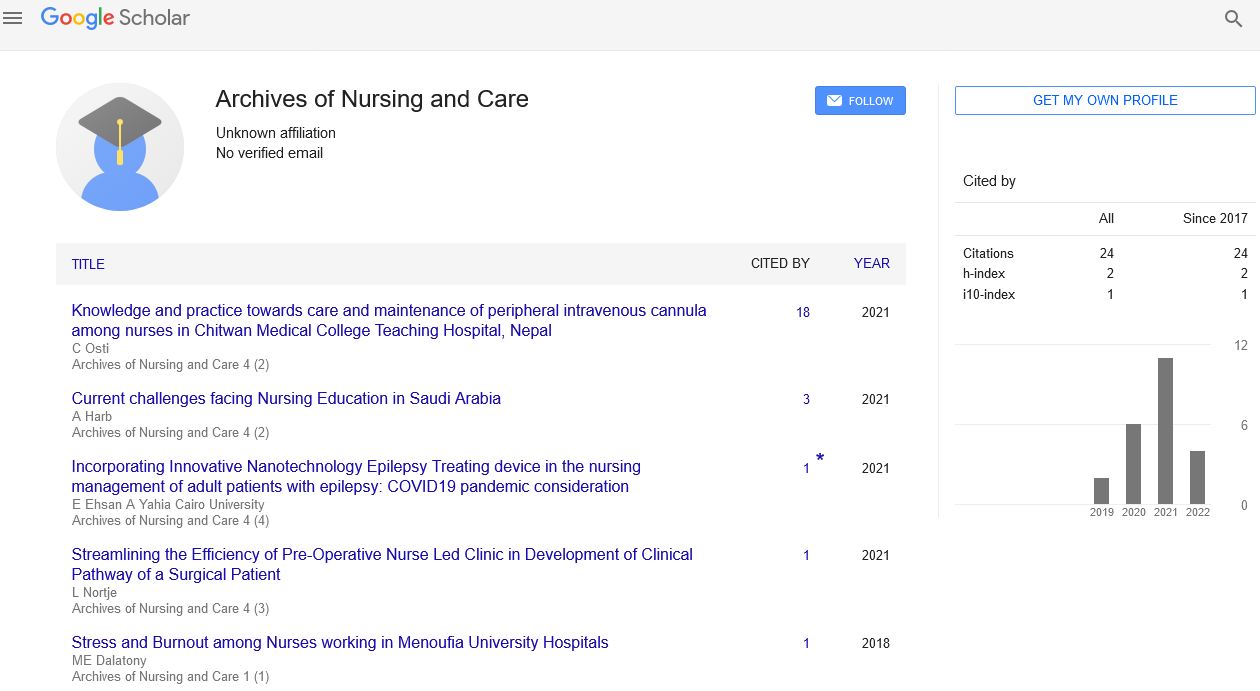Review Article - Archives of Nursing and Care (2023) Volume 6, Issue 4
A Comprehensive Study on Infection Factors and Nursing Care for Postoperative Incisions in Gynecological Cancer Patients
Elias Maria*
Pediatric Emergency Medicine, Alberta Children’s Hospital, Calgary, Canada
Pediatric Emergency Medicine, Alberta Children’s Hospital, Calgary, Canada
E-mail: Mariaelias@5286gmail.com
Received: 02-Aug-2023, Manuscript No. oanc-23-102706; Editor assigned: 04-Aug-2023, PreQC No. oanc-23- 102706 (PQ); Reviewed: 18-Aug- 2023, QC No. oanc-23-102706; Revised: 24-Aug-2023, Manuscript No. oanc-23-102706 (R); Published: 30-Aug-2023; DOI: 10.37532/ oanc.2023.6(4).106-108
Abstract
This abstract summarizes the analysis of infection factors and nursing care in relation to postoperative incisions in gynecological cancer patients. Gynecological cancer often necessitates surgical intervention, but postoperative complications, particularly incision infections, can significantly impact patient recovery. This analysis explores various factors contributing to incision infections, including surgical site contamination, patient-related factors, duration of surgery, and preoperative preparation. They were divided into the study group and control group by cluster random sampling. The control group was given routine nursing mode, including matters needing attention in surgery, health education, prevention of complications, and dietary guidance. The study group implemented the high-quality nursing mode on the basis of the control group. Postoperative situation, incision infection rate, and quality of life were observed and compared between the two groups. The control group’s time to get out of bed, postoperative eating time, postoperative exhaust time, and hospital stay were longer than those of the study group. The comparison of the postoperative related conditions of the two groups showed that P < 0:05, which indicated that the difference was statistically significant. Additionally, it highlights the importance of nursing care in preventing and managing these infections. Effective nursing care strategies, such as preoperative patient education, strict aseptic technique, prophylactic antibiotics, postoperative wound care, promotion of mobility and nutrition, and patient monitoring, are discussed. By implementing these strategies, healthcare professionals can minimize the risk of complications and enhance patient outcomes for gynecological cancer patients.
Keywords
Nursing care • Gynecological cancer • Postoperative incisions
Introduction
Gynecological cancer refers to a group of cancers that affect the female reproductive system, including ovarian, cervical, uterine, vaginal, and vulvar cancers. Surgical intervention is often a crucial component of the treatment plan for gynecological cancer patients. However, postoperative complications, particularly infections at the surgical incision site, can significantly impact patient outcomes and recovery. This article aims to analyze the various factors contributing to postoperative incision infections in gynecological cancer patients and explore the importance of nursing care in preventing and managing these infections [1].
The influencing factors of postoperative incision infection in gynecological tumor patients were analyzed, and then targeted high-quality nursing intervention programs were developed. It is helpful to improve the curative effect of gynecological tumor surgery. At the same time, nursing intervention is an important way to prevent perioperative infection. Giving targeted nursing intervention before, during, and after surgery can effectively prevent and reduce surgical infection.
The main clinical treatment for gynecological malignant tumors is surgical resection plus chemo radiotherapy. However, the surgical excision is wide, and the incision is large, therefore, once postoperative incision infection occurs in gynecological tumor patients, it will not only affect the treatment effect but also increase the burden of treatment [2]. In addition, after radiotherapy and chemotherapy, the body is damaged, the immunity is reduced, and complications are prone to occur in the perioperative period.
Factors contributing to postoperative incision infections
Surgical site contamination: The risk of infection increases when the surgical site is contaminated by endogenous or exogenous sources of bacteria, such as the patient's skin, surgical instruments, or the surgical team.
Patient-related factors: Certain patientrelated factors, such as advanced age, obesity, diabetes, smoking, compromised immune system, and poor nutritional status, can increase the susceptibility to infections.
Duration of surgery: Prolonged surgical procedures may increase the risk of infections due to prolonged exposure of the incision site to potential contaminants [3, 4].
Preoperative preparation: Inadequate preoperative preparation, including suboptimal skin antisepsis and improper hair removal techniques, can contribute to increased bacterial colonization and subsequent infection.
Nursing care to prevent postoperative incision infections
Preoperative patient education: Ensuring that patients receive clear instructions on maintaining proper hygiene, such as bathing with antiseptic soap, can help reduce bacterial load on the skin before surgery.
Strict aseptic technique: Implementing rigorous sterile techniques during surgery, including proper hand hygiene, sterile draping, and sterile equipment, can minimize the risk of contamination [5].
Prophylactic antibiotics: Administering appropriate prophylactic antibiotics before surgical incision can help prevent surgical site infections. The choice of antibiotics should be based on local guidelines and the specific needs of the patient.
Postoperative wound care: Proper postoperative wound care is crucial in preventing infections. This includes regular assessment of the incision site, changing dressings as needed, and ensuring optimal healing conditions.
Promotion of mobility and nutrition: Encouraging early ambulation and providing adequate nutritional support can enhance the patient's immune system and promote wound healing, reducing the risk of infections [6].
Patient monitoring: Regular monitoring of vital signs, incision site appearance, and laboratory parameters can help identify early signs of infection and facilitate prompt intervention.
The whole nursing process requires nursing staff to provide continuous, satisfactory, and whole-process nursing services. Changing the situation where patients or their families hire nursing workers to make up for the lack of nursing work and improve the nursepatient relationship. The control group’s time to get out of bed, postoperative eating time, postoperative exhaust time, and hospital stay were longer than those of the study group. The comparison of the postoperative related conditions of the two groups showed that P < 0:05, which indicated that the difference was statistically significant [7, 8].
The postoperative incision infection rate in the study group was 2.78%, and in the control group, the postoperative incision infection rate was 19.44%; the postoperative incision infection rate in the study group was significantly lower than that in the control group. The difference was statistically significant, P < 0:05. The factors affecting the quality of life of patients in the study group were lower than that of the control group, and the difference was statistically significant, P < 0:05 [9]. Time to get out of bed, postoperative eating time, postoperative exhaust time, hospital stay, and quality of life were the main influencing factors of postoperative incision infection in gynecological tumors. Thus, the measures implemented in the study group were conducive to postoperative recovery and improvement of quality of life. It fully embodied the clinical advantages of highquality nursing and was in line with the general trend of today’s medical reform. In summary, time to get out of bed, postoperative eating time, postoperative exhaust time, hospital stay, and quality of life were the main influencing factors of postoperative incision infection in gynecological tumors. High-quality nursing intervention in the prevention of postoperative incision infection has a better clinical nursing effect, and it should be widely used in clinical nursing [10].
Conclusion
Postoperative incision infections pose a significant challenge in the management of gynecological cancer patients. By analyzing the factors contributing to these infections and implementing appropriate nursing care strategies, healthcare professionals can significantly reduce the risk of complications and promote optimal patient outcomes. Close collaboration between the surgical team and nursing staff is crucial to ensure effective infection prevention and control measures. With a comprehensive approach that includes patient education, strict aseptic techniques, prophylactic antibiotics, and diligent postoperative wound care, the incidence of postoperative incision infections can be minimized, leading to improved recovery and quality of life for gynecological cancer patients.
References
- Januškevičius ZI, Stasiūnas AS.Transmission of physiologicalinformationby telephone.Cor Vasa. 5, 152-155 (1963).
- Balogh N, Kerkovits G, Horvath Let al.Cardiac digital image loops and multimedia reports over the internet using DICOM.StudHealthTechnol Inform. 90,148-151(2002).
- Berdusis K.The state of the art: tele-echocardiography and telecardiology.Telemed Today. 7, 25-6(1999).
- Crowe B, Hailey D.Cardiac picture archiving and communication systems and telecardiology – technologies awaiting adoption.J Telemed Telecare. 8, 3-11(2002).
- Tavakoli M, Emadi Z.The Relationship between Health-Promoting Lifestyle, Mental Health, Coping Styles and Religious Orientation among Isfahan University Students.J Res Behave Sci. 13, 64-78(2015).
- Pierce C.Health promoting behaviors of rural women with heart failure.Online Journal of RuralNursingandHealthCare. 5, 28-37(2005).
- Deblonde T, Cossu-Leguille C, Hartemann Pet al.Emerging pollutants in wastewater: A review of the literature.Int J HygEnviron Heal. 214, 442-448 (2011).
- Banci L, Ciofi-Baffoni S, Tien M Ligninet al.Peroxidase-catalyzed oxidation of phenolic lignin oligomers.Biochemistry. 38, 3205-3210 (1999).
- Heberer T.Occurrence, fate, and removal of pharmaceutical residues in the aquatic environment: A review of recent research data.Toxicol Lett.131, 5-17 (2002).
- Lee ST, Lui TN, Chang CNet al.Prophylactic anticonvulsants for prevention of immediate and early postcraniotomy seizures.Surg Neurol. 3, 361–364(1989).
Indexed at, Google Scholar, Crossref
Indexed at, Google Scholar, Crossref
Indexed at, Google Scholar, Crossref
Indexed at, Google Scholar, Crossref
Indexed at, Google Scholar, Crossref

